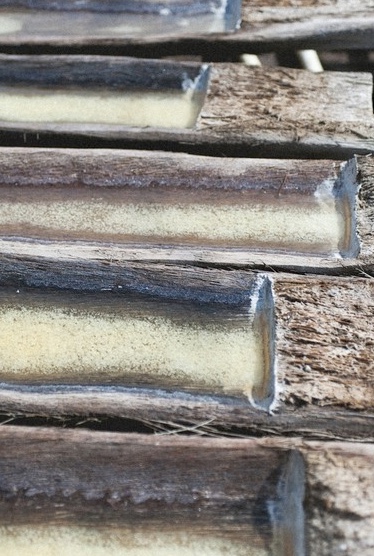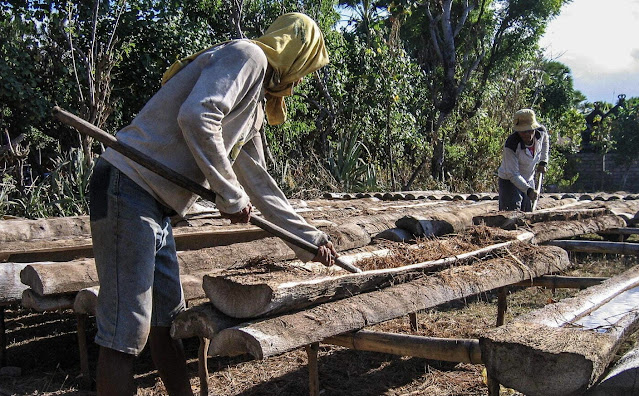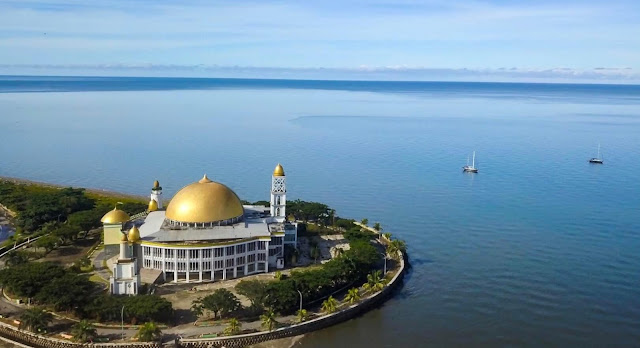During our journey through Indonesia, we aimed to explore lesser-known sailing routes, venturing into culturally diverse areas rarely visited by tourists. Our goal was to delve deeper into Indonesia's essence beyond the typical sailing path. Our last journey through Indonesia was in 2011 where we did 3578.5 nautical miles in 120 days. This time around we are well over the 5000 nautical miles in 12 months. Yes it means we have moved slower immersing, ourselves in the destinations we have visited.
Our approach to planning sailing routes differs from the norm. Instead of relying solely on a Pilot Guide, we base our plans on what fascinates us and what we desire to discover and encounter. We draw inspiration from various adventure travel experiences, not just sailing adventures, as we consider ourselves travelers who traverse vast oceans.
After using the Indonesian map, we began marking out intriguing locations that captured our interest, whether due to geography, culture, or sheer beauty. Connecting these areas, we considered weather patterns, currents, and distances. This process revealed a plan for navigating different regions of Indonesia's vast archipelago comprising 17,000 islands.
Following extensive research, we realized we would be venturing alone with limited cruising information for the areas we wished to explore. While this didn't deter us, we understood the need to acquire new skills. One crucial skill we focused on was interpreting satellite images to locate safe anchorages for our floating home.
For those considering sailing in Indonesia, we can attest that this destination ranks among the finest cruising grounds globally. Here, you'll find a diverse array of landscapes, from reef systems and lagoons to tropical islands with white, pink, and black sand, volcanoes, lush jungles, rich history dating back centuries, and unique flora and fauna. The experience is truly remarkable.
If you are considering heading in this direction, our initial recommendation is to research the specific locations and attractions you wish to explore. With over 17,000 islands spread across a sea area of more than 5.8 million square kilometers, understanding the weather patterns is crucial for planning your sailing voyage. The equatorial region presents its own set of challenges, with strong currents flowing swiftly around islands, creating unique effects and navigation complexities. It becomes evident that meticulous planning is key.
In our latest EBook Guide Part 1 - "Follow in Our Wake Indonesia," we have taken on the responsibility of easing your journey. Drawing from our passion for travel and exploration, we have curated a guide to help you discover incredible destinations while navigating the Indonesian waters.
Part 1 of the guide leads you through the Maluku Islands, an archipelago located in the eastern region of Indonesia. These remote islands, often overlooked, boast tranquil white sandy beaches, charming villages, and rich history. The mountainous islands are cloaked in lush evergreen forests that meet the pristine sandy shores and turquoise waters. Some of these picturesque destinations might even remind you of the beauty of Tahiti.
We then travel south to Indonesia's Coral Triangle, known for its vast coral reefs that are the most extensive in Southeast Asia. Indonesia, being the largest archipelagic state globally, is situated right in the heart of the Coral Triangle, which boasts the highest diversity of fish and coral worldwide.
After exploring the stunning underwater beauty, it's time to encounter the world's largest lizard, the Komodo dragon, in the breathtaking landscapes of Komodo National Park in Labuan Bajo, Indonesia. This destination offers a myriad of activities, from marveling at magnificent coral reefs to encountering manta rays, turtles, and hunting for the picturesque pink beaches.
Continuing our journey westward, we arrive at Sumbawa, known for hosting the largest volcanic eruption recorded in history. Often overlooked as travelers head to Lombok, Sumbawa awaits exploration, offering unique experiences like swimming in a volcano and encountering Whale Sharks.
Our next stop is the enchanting island of Lombok, which has often lived in Bali's shadow. In reality, Lombok provides similar if not more attractions than Bali but with fewer tourists. While it may seem like we are on the common sailing route, we unveil hidden gems in this well-traveled region that many have yet to discover.


From here, our journey takes us to Bali before returning to Lombok after indulging in a festival and experiencing the finest snorkeling in Indonesia. Back in Lombok, we cherish the most serene moments while exploring the Gili Islands. When you think of 'The Gilis,' the immediate images that come to mind are the well-known trio - Gili Trawangan, Gili Meno, and Gili Air. These islands have gained popularity as snorkeling havens, party destinations, and relaxation spots, providing a tranquil escape from the bustling Bali. However, there are more Gilis than meets the eye, with a total of 26 islands near Lombok for us to explore while waiting for the weather to shift to the NW Monsoon.
When the NW Monsoon season arrives, we seize the opportunity to venture east and then north, making stops at idyllic tropical islands along the way, immersing ourselves in their unique communities and seclusion. Our ultimate destination as we head north is Sulawesi.
As one of the four Greater Sunda Islands and the 11th largest island globally, Sulawesi lies to the east of Borneo and to the west of the Maluku Islands. Sulawesi offers a realm of marvels, from Togian to Tana Toraja, leaving visitors in awe. Our purpose here is to embrace every adventure Sulawesi has to offer. While not part of the typical tourist route or even the usual cruising paths, Sulawesi is gradually being discovered by bold travelers. Here, we delve into cultures with unique death rituals, witness breathtaking natural wonders, interact with the Bajau people, swim among tens of thousands of jellyfish in a lake discovered only in 2023, marvel at prehistoric art in remarkably preserved conditions, and bask in the pristine beauty of its rainforests.




From Sulawesi, we believed that nothing could surpass what we had seen, but Borneo proves to be another gem in Indonesia’s collection that deserves recognition. For those seeking an unconventional travel experience or remote jungle paths, Kalimantan is the perfect destination – a larger, more untamed, and less touristy part of Indonesia. Borneo Island is home to the Dayak tribes and dense rainforests housing some of the world's most diverse flora and fauna. The Indonesian section of Borneo is known as “Kalimantan” and encompasses about two-thirds of the island. While navigating the extensive river systems by boat can be challenging (yet achievable), you'll encounter regions like the Orangutan in the Jungle of Tanjung Puting National Park. We only traverse the southern coast in Part 1. But it gives us a taste of what we will be discovering on our return for the rest of the voyage around Borneo.




Having spent over twelve months sailing in Indonesia, we realize our time here is drawing to a close (Part 1), but we must sail to Malaysia due to specific reasons. The stops we make along this final stretch are equally rewarding, filled with many new experiences and discoveries.
If you are looking to venture this way our EBook Guide is another resource that can assist you in navigating your way around Indonesia especially areas not listed in the traditional Pilot Guides.
A recent reviews of the EBook said this ⬇️
“Just had a fabulous 3 days in wanci wanci. Thanks for all your information. Departed this morning for Taka Bonerate.”
“Having spent the last 5 weeks in Indonesia, I totally agree with what you have written. Having purchased a copy of your guide it is nothing short of exceptional in its detail, information and a vital source to any boat cruising through Indonesia!”
It’s not just for the sailor to navigate with interactive tracks, GPX Downloadable File, anchor coordinates and navigation hazards noted. It’s also written with the traveller in mind, what there is to see and do, what tours we did, who was the best guide, where to find the markets, supermarkets and petrol station, where we had a great meal, how much things cost.
The EBook Guide works best with the links provided to detailed Blogs and YouTube episodes on the areas we visited. This total package gives you firsthand knowledge of what we were experiencing in the region with weather conditions, current runs, anchorage options, aerial photos and Google earth imagery of our tracks into anchorages.
So head on over to Our Book Shelf and take a look at Part 1 - Follow in Our Wake Indonesia and start planing your exciting route through Indonesia. We promise you will love Indonesia.
Thank you for reading to the end of this blog. Through our social media, YouTube, Blog and Books, our goal is to provide valuable insights to help future sailors prepare effectively for their journey. If you are heading into Indonesia you maybe further interested in 2 of our other interactive Ebooks we have written.
Indonesia Awaits which is a guide to help with the officialdom of entering Indonesia
Ready to Set Sail which is a guide to help with the officialdom of leaving Australia
Please check out our Social Media on Instagram Facebook and of course our fortnightly episodes on YouTube Cheers R&K
Thank you to all who support us through watching our videos, reading our blogs or who step up and support us though
Patreon and
Ko-Fi. You inspire us everyday to be creative 🙌
You can help us out and support our creative work for FREE.
By watching, 👍, 🔔, Subscribing, Commenting and best of all Sharing this video or blog with your friends
If you would like to make a donation towards our creative work, or become a regular subscriber to Our Virtual Crew you can by heading over to Ko-Fi they take no fees so the support goes directly into helping us buy and upgrade equipment. You get behind the scenes updates,
Patreon only photos and posts, you can watch our
episodes ad free and before they go public … you get it first!
Do you want more?
Patreon gives you that … you get behind the scenes updates,
Patreon only photos and posts, you can watch our
episodes ad free and before they go public … you get it first!





















































